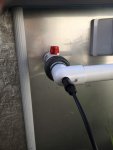I just sometimes think using pucks - like the rest of my neighborhood - is so much easier.
If it gives trouble just cut the pipe and install one of those threaded T fittings, Or cut the pipe and install a coupler and drill/tap through that, the thicker coupler gives a bit more material to thread. PVC is super easy to work with! I manage the maintenance dept in a large industrial plant so I work with plumbing, piping and pumps of all types and sizes everyday. Mechanical stuff is not everybody's skill set and can be a struggle for some folks. I recently had a friend call, completely defeated trying to replace a sink trap, it took 5 minutes and didn't even require a trip to the store.
You can maintain a pool with pucks, I did it for a few years without real understanding of the problems. After all, that's the way everybody did it??
By year 4 my pool took on that familiar aqua green color, despite dumping a few hundred dollars in shock and cranking up the tablet feeder full on it never came back. I closed it that fall planning to drain and install a new liner in the spring. Finding the pool in bad shape, I just ripped the whole thing out. I didn't have a clue then, but I know now. Ten years later here I am with a new pool, knowledge and a new outlook.
I'm sure I could use pucks again and probably figure out a system to get along. I figure you would just have to waste a bunch of water everyday to keep CYA in check or coast along in complete ignorance with minimal FC then do a major water change every time it gets out of control. I'm pretty convinced
that is how "everybody else does it".
I struggled to maintain any kind of steady FC level with pucks. No matter where I set the chlorinator the pucks either dissolved to fast or too slow so my FC was always either all but zero or over 5 on my not nearly good enough OTO kit.
I LOVE knowing right where my FC will be before I ever test. I LOVE that my pool is sparkling, clear and has no chlorine smell. I LOVE having people ask me how in the world I keep my water so clear and how I open my pool to blue water. Most of all I really appreciate knowing that my family and especially my 2 year old grandson is swimming in clean and safe water.
Once you get that stenner set up and running you will love it. Just add bleach to the tank, test FC and adjust the timer. I've considered switching to a SWG so I don't have to haul bleach anymore, but liquid injection really works great.



